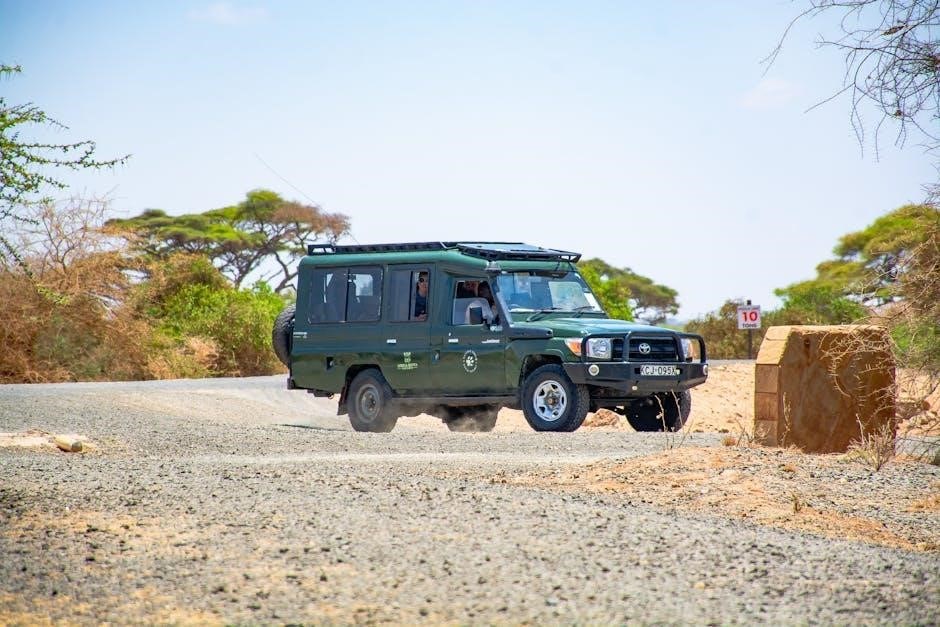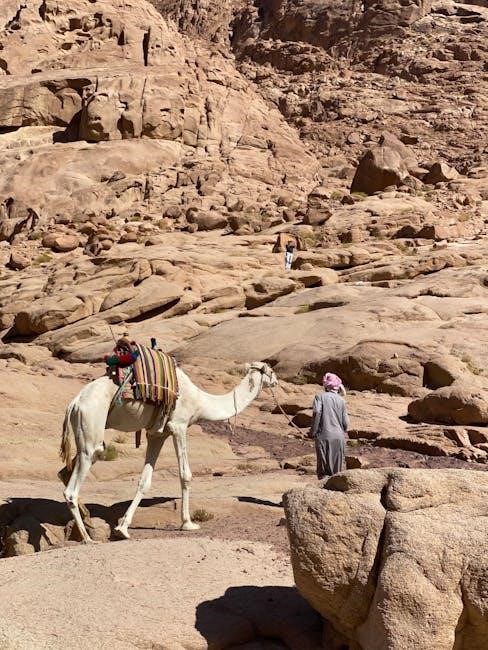
The 2024 Guide de caractérisation des terrains, published by Quebec’s Ministry of Environment, provides a comprehensive framework for terrain characterization, incorporating updated methodologies and environmental management practices.
1.1 Overview of the Guide
The 2024 Guide de caractérisation des terrains is a comprehensive document published by Quebec’s Ministry of Environment, detailing procedures for terrain characterization. It outlines methodologies for assessing soil, groundwater, and contaminated sites, ensuring compliance with environmental regulations. The guide covers phases I, II, and III of characterization studies, addressing sampling techniques, data analysis, and risk assessment. Updated in 2024, it incorporates new developments in the field, such as advanced technologies and revised legal requirements. The document aims to standardize practices, providing clarity on expectations for professionals involved in terrain management and rehabilitation. It serves as a critical resource for ensuring sustainable environmental practices and legal compliance in Quebec.
1.2 Importance of Terrain Characterization
Terrain characterization is essential for identifying and managing environmental risks, ensuring sustainable land use, and protecting ecosystems. It provides critical data on soil and groundwater conditions, enabling informed decision-making for site rehabilitation and development. By assessing contamination levels and spatial distribution, characterization helps mitigate risks to human health and the environment. It also supports compliance with legal requirements, preventing potential liabilities. The 2024 Guide emphasizes the importance of accurate characterization to guide remediation efforts effectively. This process is vital for maintaining environmental integrity and promoting responsible land management practices in Quebec, ensuring long-term ecological and economic benefits.
1.3 Updates in the 2024 Version
The 2024 Guide de caractérisation des terrains introduces significant updates, including new methodologies for soil and groundwater assessment. It incorporates advanced technologies and updated regulatory requirements, ensuring alignment with current environmental standards. The revised guide enhances clarity on special cases and exceptions, providing detailed protocols for contaminated site management. Additionally, it expands on financial assistance programs and training resources for professionals. These updates aim to improve the efficiency and accuracy of terrain characterization, facilitating better decision-making for site rehabilitation and sustainable land use. The 2024 version reflects the latest scientific advancements and practical insights, making it an indispensable tool for environmental professionals in Quebec.

Regulatory Framework and Compliance
The 2024 Guide ensures compliance with Quebec’s environmental laws, outlining legal requirements for terrain characterization. It aligns with regulations to protect soil and groundwater quality effectively.
2.1 Legal Requirements for Terrain Characterization in Quebec
The 2024 Guide de caractérisation des terrains outlines the legal requirements for terrain characterization in Quebec, ensuring compliance with environmental protection laws. It incorporates Phase I, II, and III studies, aligning with the Ministry of Environment’s standards. The guide mandates soil and groundwater assessments to identify contaminants and their spatial distribution, ensuring uniformity in characterization methods. It addresses special cases under the Environmental Protection Act, providing clear protocols for potentially contaminated sites. Professionals must adhere to these regulations to ensure lawful terrain management and rehabilitation processes. The updated guide reflects Quebec’s commitment to rigorous environmental standards.

- Compliance with environmental laws is mandatory.
- Soil and groundwater assessments are required.
- Uniform methodologies ensure accurate results.
2.2 Compliance with Environmental Protection Laws
The 2024 Guide de caractérisation des terrains ensures adherence to Quebec’s environmental protection laws, emphasizing the importance of legal compliance in terrain characterization. It outlines methodologies and standards for assessing contaminated sites, aligning with regulatory requirements. The guide mandates thorough soil and groundwater evaluations to identify pollutants and their distribution, ensuring environmental safety. Compliance is enforced through structured protocols, including Phase I, II, and III studies, and special case handling under the Environmental Protection Act. The updated guide reflects advancements in environmental law, providing clear guidelines for professionals to follow. By adhering to these standards, the guide supports both legal compliance and effective environmental protection.
- Ensures alignment with environmental laws.
- Provides structured assessment protocols.
- Supports environmental safety and legal compliance.
2.3 Role of the Ministry of Environment
The Ministry of Environment plays a pivotal role in enforcing and updating the 2024 Guide de caractérisation des terrains, ensuring its alignment with environmental protection laws. It oversees the implementation of characterization protocols, providing regulatory oversight and enforcing compliance. The ministry organizes training sessions, such as the one on June 13, 2024, to educate professionals on the guide’s updates. It also develops financial assistance programs to support terrain rehabilitation projects. By publishing the guide and offering resources, the ministry promotes standardized practices for soil and groundwater assessment, fostering environmental sustainability and public health protection.
- Enforces environmental protection laws.
- Provides training and financial support.
- Ensures standardized characterization practices.

Methodology and Procedural Steps
The 2024 Guide outlines a systematic approach to terrain characterization, detailing Phase I, II, and III procedures, soil sampling techniques, and regulatory compliance requirements.
3.1 Phases of Terrain Characterization (Phase I, II, III)
The 2024 Guide de caractérisation des terrains outlines a structured approach to terrain characterization through three distinct phases. Phase I involves preliminary site assessments, including historical research and site visits to identify potential contaminants. Phase II focuses on detailed investigations, such as soil and groundwater sampling, to confirm contamination levels and extent. Phase III centers on remediation planning and implementation, ensuring contaminated sites are restored to safe conditions. Each phase is designed to build on the previous one, providing a comprehensive understanding of site conditions and guiding effective environmental management strategies.
3.2 Soil Sampling and Analysis Techniques
Soil sampling and analysis are critical components of terrain characterization, as outlined in the 2024 Guide de caractérisation des terrains. The guide recommends systematic sampling methods, including stratified and grid-based approaches, to ensure representative data collection. Key techniques involve collecting soil cores or grab samples at varying depths, followed by laboratory analysis to determine physical and chemical properties. Parameters such as pH, organic matter content, and contaminant concentrations are prioritized. Advanced technologies, like X-ray fluorescence, may also be employed for on-site analysis. These methods ensure accurate characterization of soil conditions, enabling effective contamination assessment and informed decision-making for site management and remediation efforts.
3.4 Special Cases and Exceptions
The 2024 Guide de caractérisation des terrains addresses special cases and exceptions, ensuring comprehensive coverage of unique scenarios. These include contaminated sites requiring tailored methodologies, exceptional soil types, and sites with complex hydrogeological conditions. The guide provides adaptive strategies for characterization, such as adjusting sampling densities or incorporating advanced technologies for challenging terrains. Specific exceptions, like sites with high concentrations of contaminants or unique geological formations, are detailed to ensure accurate assessments. Additionally, the guide outlines alternative approaches for sites with limited accessibility or sensitive ecosystems, balancing thorough characterization with environmental protection. These special considerations enhance the guide’s versatility, making it a robust tool for diverse terrain management scenarios in Quebec.

Soil and Groundwater Characterization
The 2024 Guide de caractérisation des terrains emphasizes soil and groundwater characterization through detailed physical and chemical analyses, advanced sampling techniques, and comprehensive risk assessments to ensure effective environmental protection and sustainable land management.
4.1 Physical and Chemical Properties of Soils
The 2024 Guide de caractérisation des terrains details the analysis of soil physical and chemical properties, such as texture, organic matter content, pH, and contaminant concentrations. These properties are essential for assessing soil quality and potential contamination risks. Advanced laboratory techniques are recommended to determine nutrient levels, heavy metal presence, and organic compound concentrations. Understanding these properties helps in classifying soils and determining appropriate rehabilitation strategies. The guide also emphasizes the importance of spatial variability in soil characteristics, requiring systematic sampling to ensure accurate representation of site conditions. This data is critical for developing effective environmental management plans and ensuring compliance with regulatory standards.
4.2 Groundwater Assessment and Monitoring
The 2024 Guide de caractérisation des terrains emphasizes the importance of groundwater assessment and monitoring in understanding soil and environmental health. It outlines methodologies for sampling and analyzing groundwater to detect contaminants and assess their impact on aquatic ecosystems. The guide highlights the need for hydrogeological studies to determine groundwater flow patterns and potential contamination pathways. Regular monitoring ensures the early detection of pollution, enabling timely intervention to prevent further environmental damage. Advanced technologies, such as piezometers and multi-level wells, are recommended for accurate data collection. The guide also provides protocols for interpreting groundwater data and integrating it into broader environmental management strategies to protect drinking water sources and maintain ecosystem balance.
4.3 Risk Assessment for Contaminated Sites
The 2024 Guide de caractérisation des terrains provides detailed methodologies for conducting risk assessments at contaminated sites. It emphasizes identifying contaminants, their concentrations, and spatial distribution to evaluate potential risks to human health and the environment. The guide outlines a systematic approach, including site history analysis, soil and groundwater sampling, and toxicity assessments. It also addresses exposure pathways and receptor characterization to determine the likelihood of contamination impacts. Risk assessment results are used to prioritize remediation efforts and ensure compliance with environmental protection laws. The guide aligns with Quebec’s regulatory framework, offering tools and criteria to support decision-making for site rehabilitation and long-term environmental sustainability.

Tools and Resources for Characterization
The 2024 Guide provides specialized software, financial aid programs, and training workshops to support terrain characterization, ensuring professionals have access to modern tools for accurate assessments.
5.1 Software and Technologies for Data Analysis
The 2024 Guide emphasizes advanced software tools for efficient data analysis in terrain characterization. These include Geographic Information Systems (GIS) for spatial mapping and machine learning algorithms to interpret complex datasets. Specialized platforms enable professionals to process soil and groundwater data, ensuring accurate assessments. The guide highlights user-friendly interfaces and real-time data integration, facilitating decision-making. Additionally, it recommends open-source tools for cost-effective solutions. These technologies streamline the characterization process, enhance precision, and support compliance with environmental regulations. By leveraging these tools, professionals can manage large datasets effectively, ensuring comprehensive and reliable terrain assessments. The guide also provides resources for training on these technologies, promoting widespread adoption and consistency in practices across Quebec.
5.2 Financial Assistance and Funding Programs
The 2024 Guide highlights various financial assistance programs to support terrain characterization and rehabilitation projects. These include government grants, tax incentives, and subsidies aimed at reducing costs for stakeholders. The Ministry of Environment offers funding for soil and groundwater assessments, particularly for contaminated sites requiring remediation. Additionally, partnerships with organizations provide resources for innovative projects. These programs aim to encourage sustainable land management and compliance with environmental regulations. professionals and organizations. The guide also outlines eligibility criteria and application processes for these programs. By leveraging these financial tools, stakeholders can efficiently manage terrain characterization efforts while promoting environmental protection and sustainable development across Quebec.
5.3 Training and Workshops for Professionals
The 2024 Guide emphasizes the importance of training and workshops for professionals involved in terrain characterization. The Ministry of Environment offers free training sessions, such as the one held on June 13, 2024, focusing on recent updates and tools. These programs aim to enhance skills in soil and groundwater assessment, ensuring compliance with environmental standards. Workshops also cover practical applications of the guide, addressing challenges in contaminated site rehabilitation. Professionals gain insights into new methodologies and technologies, fostering best practices in terrain management. Such initiatives support continuous learning and adaptation to evolving regulations, ensuring effective implementation of the guide’s recommendations across Quebec.

Case Studies and Practical Applications

The 2024 Guide highlights successful terrain rehabilitation projects, shares lessons from past studies, and showcases innovative approaches in managing contaminated sites effectively.

6.1 Successful Projects in Terrain Rehabilitation
The 2024 Guide showcases several successful terrain rehabilitation projects in Quebec, demonstrating effective methodologies for contaminated site management. These case studies highlight how innovative approaches, such as advanced soil remediation techniques and groundwater monitoring, have led to significant improvements in environmental quality. For instance, a project in Montreal successfully restored a former industrial site by integrating characterization data with remediation strategies, achieving compliance with environmental standards. Another example involves the use of phytoremediation to clean up contaminated soils, showcasing cost-effective and sustainable solutions. These projects underscore the importance of adhering to the Guide’s updated protocols and leveraging financial assistance programs to ensure long-term site rehabilitation. They serve as benchmarks for future initiatives, promoting best practices in terrain management and environmental protection.
6.2 Lessons Learned from Previous Characterization Studies
Previous characterization studies have provided valuable insights into improving terrain rehabilitation practices. The 2024 Guide highlights key lessons, such as the importance of robust soil sampling strategies and the integration of advanced data interpretation techniques. Challenges identified in earlier studies, including inconsistent data quality and the need for better contaminant migration modeling, have informed the updated methodologies. These lessons emphasize the critical role of accurate site assessment and the value of incorporating stakeholder feedback. By addressing past limitations, the Guide now offers more reliable frameworks for characterizing contaminated sites, ensuring effective remediation and long-term environmental protection. These insights are instrumental in shaping modern approaches to terrain management and rehabilitation efforts.
6.3 Innovative Approaches in Terrain Management
The 2024 Guide de caractérisation des terrains introduces innovative approaches to terrain management, focusing on sustainable rehabilitation and advanced technologies. Key innovations include the use of 3D modeling for site characterization, real-time monitoring systems, and adaptive management strategies. The integration of emerging technologies, such as machine learning for data analysis, enhances the accuracy of contaminant mapping and risk assessment. Additionally, the Guide promotes the use of bioremediation techniques and green technologies to restore ecosystems. These approaches align with global environmental trends, emphasizing cost-effectiveness and long-term sustainability. By adopting these innovative methods, professionals can achieve better outcomes in terrain rehabilitation, ensuring compliance with evolving regulations and protecting environmental health for future generations.
Future Trends and Developments
The 2024 Guide highlights emerging technologies and sustainable practices, emphasizing advancements in data analysis tools and eco-friendly rehabilitation methods to enhance terrain management and environmental protection.
7.1 Emerging Technologies in Terrain Characterization

Emerging technologies are revolutionizing terrain characterization, offering advanced tools for data collection and analysis. Geospatial mapping, artificial intelligence, and IoT sensors enable precise soil and groundwater assessments. These innovations improve accuracy, reduce costs, and enhance decision-making. AI-driven predictive models forecast contamination risks, while real-time monitoring systems track environmental changes. Such technologies align with sustainable practices, supporting efficient terrain rehabilitation and compliance with evolving regulations. These advancements ensure better environmental protection and resource management, making terrain characterization more effective and efficient in addressing modern challenges. The integration of these technologies underscores the commitment to innovation in environmental stewardship, as outlined in the 2024 Guide de caractérisation des terrains.
7.2 Evolving Regulations and Standards
Regulations and standards for terrain characterization are continuously evolving to address emerging environmental challenges. The 2024 Guide de caractérisation des terrains reflects these changes, incorporating stricter requirements for soil and groundwater assessments. Updated legal frameworks ensure compliance with environmental protection laws, emphasizing sustainable practices and public health safety. The Ministry of Environment plays a key role in refining these standards, ensuring they align with scientific advancements and societal needs. As regulations evolve, they drive the adoption of innovative technologies and methodologies, fostering a more robust approach to terrain management. These updates underscore the importance of adapting to environmental and technological advancements, ensuring effective terrain characterization and rehabilitation practices.
7.3 Public Awareness and Engagement
Public awareness and engagement play a crucial role in the effective implementation of the 2024 Guide de caractérisation des terrains. The Ministry of Environment has emphasized the importance of educating communities and professionals about terrain characterization through workshops and training sessions. For instance, a free training session on recent updates to the guide was held on June 13, 2024, highlighting the significance of public involvement. Additionally, the guide’s availability online and its distribution through libraries and governmental platforms ensure accessibility. These efforts aim to foster a collective understanding of environmental responsibilities, encouraging active participation in sustainable land management. Public engagement also promotes transparency and collaboration, ensuring that stakeholders are well-informed and committed to protecting Quebec’s environment for future generations.